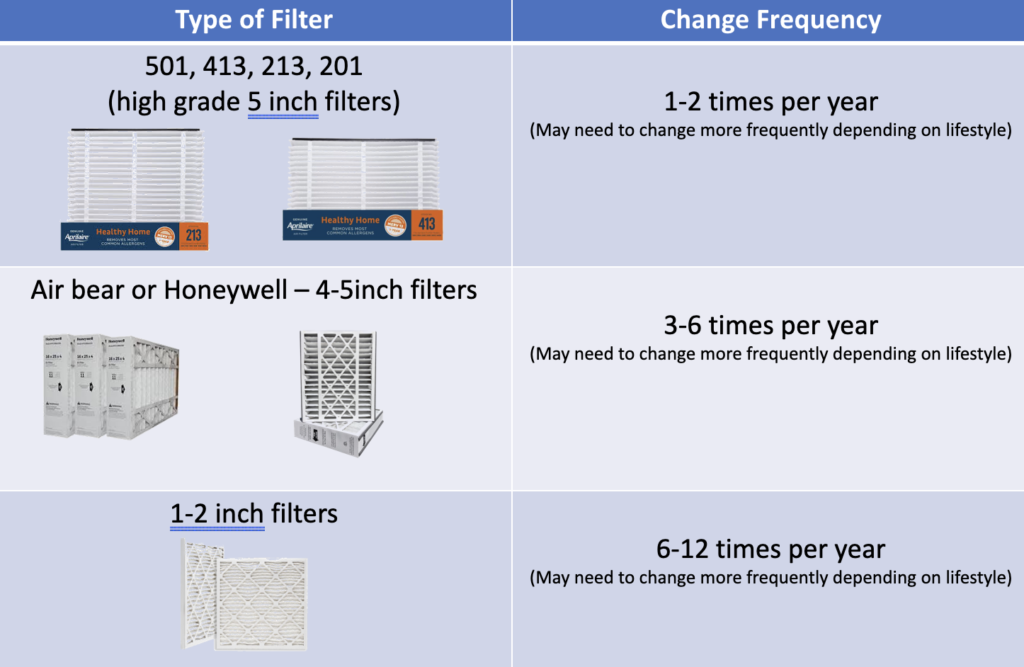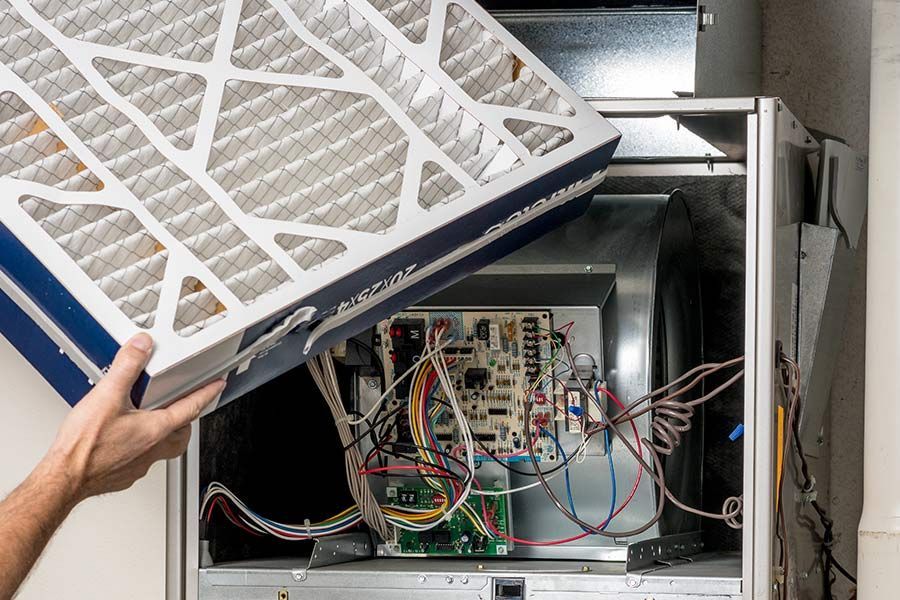How Often Do You Replace Furnace Filters

Maintaining a furnace involves several tasks, but one of the simplest and most crucial is regularly replacing the air filter. This small component has a big impact on your HVAC system's performance, efficiency, and lifespan. While a universal replacement schedule doesn't exist, understanding the factors that influence filter lifespan is key to keeping your system running smoothly.
Why Replace Furnace Filters?
Before diving into the frequency, it's essential to understand the function of a furnace filter. Think of it as the lungs of your HVAC system. It traps dust, pollen, pet dander, and other airborne particles, preventing them from circulating throughout your home and damaging sensitive furnace components. A clean filter ensures:
- Improved Air Quality: Removes allergens and pollutants, creating a healthier indoor environment.
- Increased Energy Efficiency: A dirty filter restricts airflow, forcing the furnace to work harder and consume more energy.
- Extended Furnace Lifespan: Reduced strain on the system minimizes wear and tear, preventing costly repairs and premature replacement.
- Reduced Repair Costs: Clean filters prevent dust build-up on crucial components such as the blower motor, heat exchanger, and flame sensor.
Factors Affecting Filter Replacement Frequency
The ideal replacement schedule depends on several variables. Consider these factors to determine the appropriate frequency for your specific situation:
Filter Type
Furnace filters are available in various materials and thicknesses, each with a different lifespan:
- Fiberglass Filters: These are the least expensive and most basic filters. They primarily protect the furnace from large debris but offer minimal air filtration. Replacement is generally recommended every 30 days.
- Pleated Filters: Made of pleated paper or cloth, these filters offer better filtration and longer lifespan than fiberglass filters. They are a popular choice for homeowners. Replacement is typically needed every 90 days.
- Electrostatic Filters: These filters use an electrostatic charge to attract and trap particles. They offer good filtration and can be washable, reducing waste. Replacement or cleaning is usually recommended every 90 days.
- HEPA Filters: High-Efficiency Particulate Air (HEPA) filters provide the highest level of filtration, capturing 99.97% of particles 0.3 microns or larger. They are ideal for individuals with allergies or respiratory problems. Replacement is usually needed every 6-12 months, depending on usage and air quality.
Home Environment
The conditions inside your home significantly impact filter lifespan:
- Pets: Homes with pets, especially those that shed heavily, require more frequent filter changes. Pet dander and hair can quickly clog filters, reducing airflow and increasing the risk of furnace problems. Consider changing the filter every 30-60 days.
- Allergies and Asthma: Individuals with allergies or asthma benefit from more frequent filter changes to minimize airborne allergens and irritants. Aim for replacement every 30-60 days, especially during peak allergy seasons.
- Construction or Remodeling: Construction activities generate large amounts of dust and debris, which can quickly clog furnace filters. Change the filter monthly or even more frequently during and immediately after construction projects.
- Number of Occupants: Homes with more occupants generate more dust and require more frequent filter changes.
Furnace Usage
The amount you use your furnace affects the filter's lifespan. Homes in colder climates that require frequent heating will need more frequent filter changes than homes in milder climates.
- Seasonal Usage: If you only use your furnace during the winter months, you may be able to extend the filter replacement interval during the off-season. However, it's still a good idea to check the filter periodically and replace it if it appears dirty.
- Constant Operation: Furnaces that run frequently require more frequent filter changes.
Filter Size and MERV Rating
Minimum Efficiency Reporting Value (MERV) ratings indicate a filter's ability to capture particles. Higher MERV ratings mean better filtration but also potentially reduced airflow, especially with thicker filters.
- Filter Size: A larger filter surface area can trap more dirt and debris before needing replacement.
- MERV Rating: Filters with higher MERV ratings (e.g., MERV 11-13) trap smaller particles but can restrict airflow if your HVAC system isn't designed for them. Consult your HVAC professional for guidance on selecting the appropriate MERV rating for your system. A MERV 8 filter is generally a good balance of filtration and airflow for most residential systems.
General Guidelines for Filter Replacement
While the factors mentioned above play a crucial role, here are some general guidelines:
- Standard 1-inch Filters: Replace every 30-90 days.
- Thicker 4-5 inch Filters: Replace every 6-12 months.
Always check your filter monthly, regardless of the recommended replacement interval. Hold it up to the light; if you can't see light passing through easily, it's time for a replacement.
The Cost of Neglecting Filter Replacement
While the cost of a new furnace filter is relatively low, the consequences of neglecting replacement can be significant. These consequences include:
- Higher Energy Bills: A dirty filter forces the furnace to work harder, consuming more energy and increasing your monthly energy bills.
- Furnace Damage: Restricted airflow can cause the furnace to overheat, leading to component failures and costly repairs.
- Reduced Air Quality: A clogged filter can release trapped particles back into the air, worsening indoor air quality and potentially triggering allergies or asthma symptoms.
- Premature Furnace Failure: Over time, the strain on the furnace caused by a dirty filter can shorten its lifespan, requiring premature replacement.
Best Practices for Filter Replacement
Follow these best practices to ensure proper filter replacement:
- Turn off the furnace: Before replacing the filter, turn off the furnace at the thermostat or breaker to prevent injury or damage.
- Locate the filter: The filter is typically located in the blower compartment or near the return air duct.
- Note the airflow direction: Observe the arrow on the filter frame, which indicates the direction of airflow. Install the new filter with the arrow pointing in the same direction.
- Dispose of the old filter properly: Wrap the old filter in a plastic bag before disposing of it to prevent dust and debris from escaping.
- Set a reminder: Use a calendar or app to set reminders for monthly filter checks and replacements.
For HVAC Technicians and Facility Managers
For HVAC technicians and facility managers maintaining multiple units, a proactive approach to filter maintenance is crucial. Implement a regular filter inspection and replacement schedule based on the specific needs of each system and building. Consider using smart filters that provide real-time filter status and alerts. Track filter replacement data to identify trends and optimize maintenance schedules. Educate building occupants about the importance of filter replacement and its impact on air quality and energy efficiency. Consider bulk purchasing options to reduce costs. Furthermore, documenting filter changes provides a record of maintenance, which can be beneficial for warranty claims and future troubleshooting.
Choosing the Right Filter
Selecting the right filter involves balancing filtration efficiency with airflow. A filter with a higher MERV rating will capture more particles, but it can also restrict airflow, especially in older systems not designed for such dense filtration. Consult with a qualified HVAC technician to determine the appropriate MERV rating for your furnace. Consider factors such as allergy concerns, pet ownership, and the presence of respiratory sensitivities when making your selection. Ensure the filter fits properly within the furnace housing to prevent air bypass. Some manufacturers offer filter subscription services, which automatically ship replacement filters to your doorstep on a regular schedule.
Professional HVAC Maintenance
While homeowners can perform basic filter replacement, regular professional HVAC maintenance is essential for ensuring optimal system performance and longevity. Schedule annual or bi-annual tune-ups with a qualified HVAC technician to inspect and clean all furnace components, including the blower motor, heat exchanger, and burners. Professional maintenance can identify and address potential problems before they lead to costly repairs or system failure. A well-maintained furnace will operate more efficiently, provide better indoor air quality, and last longer.
By understanding the factors that influence filter lifespan and following a consistent replacement schedule, you can ensure your furnace operates efficiently, provides clean air, and lasts for years to come. Remember, a small investment in filter maintenance can save you significant money and headaches in the long run.










